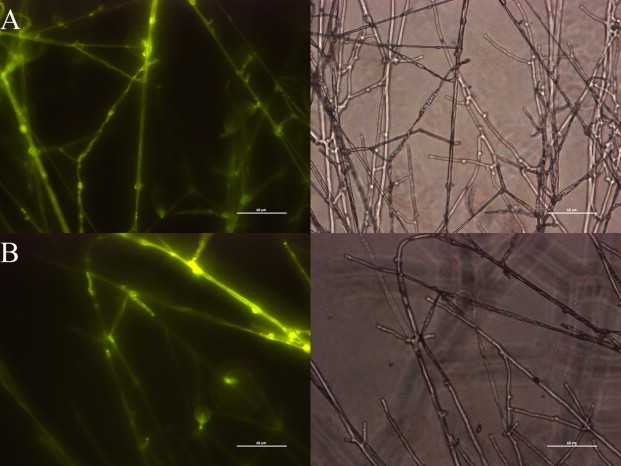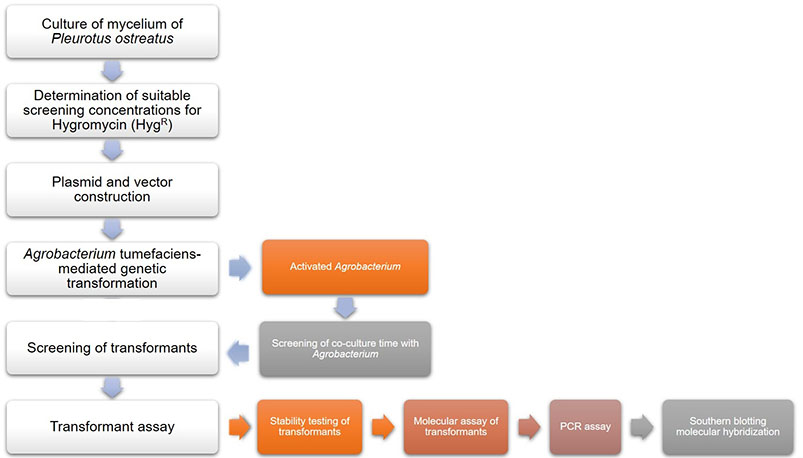As an edible fungus, Pleurotus ostreatus is widely cultivated because of its delicious flesh, unique flavor, and rich nutrition, as well as its high yield, low cost, wide adaptability, strong resistance, high nutritional value, good economic benefits, short growth cycle, and easy to master cultivation techniques. However, due to the long-term asexual reproduction of Pleurotus ostreatus, the strains are degraded and the yield is reduced, in the meantime, the traditional breeding technology has problems such as long period, slow effect, and instability, so there is an urgent need to explore more efficient and stable breeding methods, and the development of genetic engineering technology has opened a new way for strain selection and breeding.
Lifeasible has established a platform to provide a stable and efficient Agrobacterium-mediated Pleurotus ostreatus genetic transformation system.
Lifeasible provides two screening markers for Pleurotus ostreatus, the nutrient-deficient marker and the antibiotic resistance marker. The most commonly used screening marker is the antibiotic resistance marker. Nutrient-deficient edible strains are not readily available and are prone to revertant mutations. Natural resistance markers are not used much in fungi, mainly because fungi have strong resistance to bacterial antimicrobials. In contrast, Hygromycin is a widely used antimicrobial agent and has been used since 1992 for resistance transformation in Lentinula edodes, so we recommend you to choose Hygromycin (HygR) resistance screening method in Pleurotus ostreatus genetic transformation.
Lifeasible provides several Agrobacterium strains such as LBA4404, GV3101, EHA105, AGL-1, etc. And we also provide several optional vectors including pAN7-1, pLC-bar, pLG-hph, pLC-GUS, pTM1, PBHt1, pCAMBIA1302, etc., all of which can be integrated into the host chromosome to build a stable Pleurotus ostreatus genetic transformation system for you.
Lifeasible provides Pleurotus ostreatus promoters mainly as strong promoters and homologous promoters, including ras promoter, gpd promoter, sdi promoter. The use of homologous promoters not only facilitates the recognition of regulatory factors and reduces methylation, but also facilitates the recognition and binding of host cell RNA polymerase and the improvement of transformation efficiency.
 Figure 1. Expression of eGFP in separate P. ostreatus transformants without (A) or with (B) hygromycin. (Ding Y, et al. 2011)
Figure 1. Expression of eGFP in separate P. ostreatus transformants without (A) or with (B) hygromycin. (Ding Y, et al. 2011)
The recombinant plasmid was transferred into Agrobacterium tumefaciens, and the target gene was transferred into Agrobacterium tumefaciens by Agrobacterium tumefaciens-mediated method using Pleurotus ostreatus mycelium as the recipient material. This is a very complete and mature system, and our technical team has a lot of experience.

Lifeasible uses recombinant genetic techniques and genetic manipulation to modify Pleurotus ostreatus strains to obtain desired traits or cellular characteristics. Agrobacterium-mediated transformation with substratum hyphae as recipients is more efficient, but substratum has the problem of being more time-limited in fetching material, long cultivation period, and time-consuming management. Therefore, we developed a stable, simple, and efficient method for Agrobacterium-mediated transformation using Pleurotus ostreatus mycelium as the receptor, and provided technical services for molecular genetic breeding of Pleurotus ostreatus and other edible fungi as well as genetic transformation studies of other filamentous fungi.
Reference: